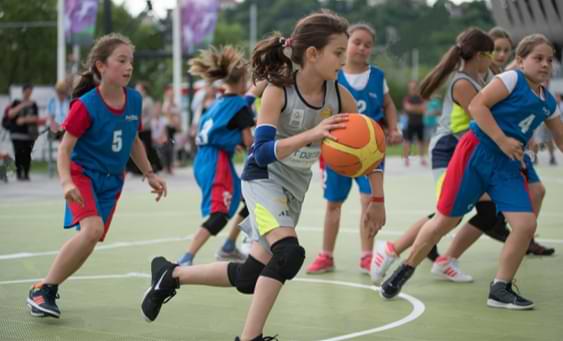How and Why Height Increases and Body Grows During Puberty stage
Before discussing what you should do to grow taller during puberty stage, you need to understand what puberty stage means and whether you are in puberty stage or past it.

What is puberty stage?
Puberty is the stage in life when young boys and girls begin to transform into adults.
Teenagers become sexually mature and their bodies begin to transform into adult bodies.
This usually happens between ages 8 and 14 for girls and ages 9 and 15 for boys though in some cases puberty stage may end later for some teenagers.
It is during puberty stage that kids grow taller more rapidly. [1]
What are the signs of entering Puberty stage?
Before boys and girls enter puberty stage, the only difference on their bodies is their genitalia.
However, when they reach puberty stage, they are affected differently
Girls:
Girls normally develop breasts first before pubic hair grows though in some cases, pubic hair grows first.
The first menstruation which occurs between 12 and 13 years is the most obvious sign that a girl has entered puberty stage and it normally occurs after breast and pubic hair development.
When do girls stop growing taller?
Girls normally grow 2-4 inches in a period of about 2 years from the time they started to menstruate then they stop growing.
https://tinyurl.com/ycynjfdt
When do boys stop growing taller?
Puberty usually begins with the testicles and penis getting bigger.
Then hair grows in the pubic area and armpits.
Muscles grow, the voice deepens, and occasionally pimples and facial hair develop as puberty continues.
The most obvious sign of puberty in boys is the first ejaculation which usually occurs when the child is around 13 years old.
During puberty stage, teenagers experience a growth spurt for about 3 years and during this time, they grow rapidly.
After the growth spurt, children almost reach their final adult height but they may grow slightly before puberty finally ends.
So, when you are aged 13, 14, 15 or even 16, chances are high that you are still in puberty stage and you will cotinine to grow taller.
How and why there is a Growth spurt during puberty
First of all, puberty is initiated by gonadotropin-releasing hormone released by the hypothalamus.
Gonadotropin-releasing hormone then flows to the anterior pituitary from where it controls the secretion of female and male hormones to the gonads (ovaries in a girl, the testes in a boy)
https://tinyurl.com/2k6nhhht
In response to the signals, the gonads release hormones that ;
~ Arouse sexual desire (libido) and the growth function.
~ Develop the brain, muscles, the breasts and private parts.
~ Accelerate the growth of bones and hair.
Differences in height increase Between Girls and boys During Puberty.
Body growth and development in height and or weight is rapid during the first few years of puberty and it ends when teenagers develop adult bodies.
In boys, growth during puberty adds approximately 30- 31 cm which is equivalent to a foot .
While girls grow approximately between 27 and 30 cm.
https://tinyurl.com/3dcdch77
The timing of the pubertal growth spurt occurs earlier in girls, on average 2 years earlier than boys but does not reach the magnitude of growth among boys.
During the period of most rapid growth, girls grow up to roughly 3.5 inches every year while boys 4.1 inches every year.
Since on average puberty ends earlier for girls than boys, the extra years of puberty for boys coupled with the fact that they grow more rapidly than girls during puberty accounts for the difference in average height between men and women of up to 10 – 15 cm.
Much of the height gain comes from increase in torso length.
The series of rapid growth during puberty normally begins with the feet, and finalizes with the torso after the hands and legs have grown.
During puberty, most boys will gain more muscle while girls will gain more fat.
What should you do to grow taller naturally at 14, 15 and 16 ?
Now that you know what puberty is, if you are older than 17 years and still wish to add a couple of inches to your height, download and read..
The Grow Taller After Puberty Exercise Routine Handbook here »»»
If you are yet to enter or still in puberty ( age 15 and below), taking the initiatives below will help you to grow taller or reach your genetically determined height.
1. Avoid childhood or adolescence sex
Sex during puberty can lead to stunted growth simply because, sex is construed as a “stressor” by the young adolescent body which leads the immune system into overdrive resulting into inflammations.

An Inflammation occurs when the immune system reacts to a foreign agent like bacteria or a virus.
For instance, when your finger or wound swells, it may be a sign of an inflammation.
This means that the inflammation process begins before you even notice the symptom say wound swelling.
https://tinyurl.com/2f37c26w
Inflammations may result in conditions such as IBS ( Irritable Bowel Syndrome).
Irritable Bowel Syndrome is a digestive system disorder that causes symptoms like bloating, diarrhea, constipation and stomach aches.
Irritable Bowel Syndrome can delay the onset of puberty and affect growth.
This hypothesis is based on experiment that was conducted on 40 day old hamsters which are comparable to human teenagers [2]
2. Sleep adequately
According to the National Sleep Foundation, children aged 6 to 13 years should sleep for at least 9 to 11 hours while teenagers aged 14 to 17 years should sleep for at least 8 – 10 hours.
Adults aged 18 years and above should sleep for 7 to 9 hours.
Sleep is very vital for body growth and development.
It promotes bone formation, its during deep sleep that the greatest amount of growth hormones is released and studies show that majority of bone growth takes place while we are sleeping.

A study that aimed to investigate whether chronic sleep deprivation had any impact on bone development established that bone formation among sleep deprived rats was halted yet bone wasting continued.
Thus, their bones continued to decrease in density.
Another study that included baby lambs found that almost all bone growth takes place when we are resting or sleeping.
Unfortunately, A 2009 study that included students aged 12 to 18 at Drexel University found that 80% of the students in that age group sleep less than 8 hours every night.
And that the average teenager in the US sleeps for 7 hours a night.
This was attributed to multimedia usage and taking caffeinated drinks late in the night.
Research however shows that your brain won’t be as effective in retaining new information when you stay awake all night reading as it would if you had a sufficient amount of sleep.
Read more on how sleep facilitates body growth .
3. Consider G.H injections or supplementation
Just like the name, growth hormones are responsible for growth and development of body tissues.
The tissues include muscles, bones and body organs.
If your growth plates are still open, growth hormones catalyze the division of cells at growth plate cartilage which triggers heightened rates of bone formation, resulting to increased bone length.
Hence, sometimes a child may be short without any apparent reason or cause like endocrine disorders, malnutrition or any illness despite having relatively taller parents.
In such instances, G.H treatment may be considered an option.

Back in 2003, the Food Drug Administration of the United states approved the treatment of such cases of short stature with recombinant human growth hormone and such therapy has proven to be effective in increasing growth velocity thus increasing the chances of children reaching adult height.
In fact, one study that aimed to investigate the efficacy of recombinant growth hormones in increasing height velocity among pre pubertal south Korean children with short stature, established that those who were treated with 0.067 mg per kg weight of recombinant growth hormones for 6 months grew more rapidly after a period of 6 months.
And another study that aimed to assess the efficacy of treating short adolescent boys with growth hormones from the onset of puberty, also established that boys who were treated with approximately 42 micro grams of G.H everyday grew slightly but significantly after approximately one year.
However, G.H injections or supplements should be administered under strict medical supervision due to the potential side effects.
4. Exercising
Exercise provides loading/ forces necessary for the growth of the skeletal muscles as well as remodeling and increased density of skeletal bones all of which contributes to bone length.
Besides contributing to bone remodeling and density, exercises can also trigger the release of hormones necessary for growth particularly human growth hormones, testosterone and thyroid hormones.
The effects of physical activity on growth reveals that physically active pre – pubertal boys appear to be larger, heavier, and have larger upper arm and calf circumferences than their physically inactive counterparts.
Therefore, high -strain sports activities that require lots of jumping and running like basketball, football, baseball, handball and alike should begin at a younger age before puberty commences and be continued through the puberty stage of development for optimal bone mass to be achieved.

Excessive mechanical strain or exercises may however suppress the growth of organs during childhood and adolescence thereby negatively affecting growth and development during puberty.
Before a child enters puberty, the responsiveness of skeletal bones to physical activity is relatively high.
Thus, at a young age children don’t need too much exercise for a significant amount of bone to be formed.
3 hours of exercising is enough to be precise.
Excessive exercise is associated with delayed pubertal changes.
Sports that put emphasis on particular weight control and require high-energy output are likely to have a negative impact on pubertal growth spurt. [3]
Examination of male scholastic wrestlers has demonstrated reduced vertical body growth during the active sports season then catch up growth during the season break.
Analysis of elite female gymnasts and dancers has likewise demonstrated delayed growth and pubertal maturation during periods of intense training.
Exercise in children may provide a conflicting stimuli to body growth simply because its energy costs can reduce the nutrients available or necessary for growth.
https://tinyurl.com/48ezcjbm
If you wish to exercise during puberty but you are not involved in any kind sport, there are both torso lengthening and leg lengthening exercises that you can regularly perform during puberty stage to accelerate growth so creating an exercise routine will be a good idea.
5. Delay growth plates closure
According to studies, there are a couple of supplements and drugs you can use to delay the closure of your growth plates if you are still in puberty.
Such medicines and supplements include; Resveratrol, tamoxifen and aromatase inhibitors like arimidex and letrozole.
All drugs and supplements should however be used under medical supervision.
more reading about the above drugs, how they delay growth plates fusion, when, how, and why growth plates close can be done on How and why growth plates close page
6. Choose what you eat wisely.
One of the critical factors that influence body growth and development during puberty is nutrition.
A healthy diet that is both adequate and balanced is necessary for normal growth and development during the three phases of growth that is infancy, childhood and puberty.

During the stage of puberty, a growth spurt is triggered which increases the need for both macro nutrients like Carbohydrates, fat and protein and micronutrients like Vitamins and minerals.
Vitamins are necessary for energy production, while, minerals play an important role in growth and bone health.
Hence, an increase in the intake of calories, folate (B9 vitamin), proteins, zinc calcium and iron should be a priority during this critical stage of rapid growth.
https://tinyurl.com/zt74ysr8
According to the American Dietary Guidelines (2010), girls aged 9 – 13 require 1400 to 2200 calories and girls aged 14 – 18 need 1800 – 2400 calories each day during puberty.
Physically active girls require more calories during puberty than those who are not very physically active.
Boys in puberty stage require more calories than girls accountable by larger frames and bigger muscle mass.
Hence, Boys aged 9 to 13 require 1600 to 2600 calories, and teen boys aged 14 to 18 need 2000 to 3200 calories per day to maintain healthy body weights.
However, the caloric requirements for teenage athletes who regularly participate in vigorous sports training are much higher.
Requiring up to 5,000 calories every day.
https://tinyurl.com/3744xh6r
More reading about nutrition can be done on foods to eat to grow taller during and after puberty page.
7. Avoid cigarette Smoking
Nicotine is the most abundant chemical found in the dried tobacco leaves used for smoking in cigarettes.
Nicotine constricts blood vessels thereby reducing blood flow to tissues including bones.
Bones require a substantial amount of blood supply for oxygen and nutrients.
https://tinyurl.com/yrhx56eu
Secondly, though low levels of nicotine increase the production of cells responsible for bone formation (osteoblasts), at higher levels it inhibits osteoblast production, resulting in cell death and thus impaired bone formation or growth.
Finally, researchers have found that smoking impairs intestinal calcium absorption which is necessary for optimal bone health.

A study published in the journal of Epidemiology to investigate if cigarette smoking had any influence on height or growth found that boys who smoked were on average up to an inch shorter than those who didn’t smoke.
Cigarette smoking however had no influence on girl’s height.
Another study published in the same journal also established that passive smoking also stunts a child’s growth.
This was after the data that was collected from over 5000 primary school children linked the child’s height to the quantity of cigarette sticks smoked by the parents at home.
https://tinyurl.com/3f7a9dn3
8. Avoid taking drugs like marijuana
Tetrahydrocannabinol (THC) the main psychoactive compound in cannabis that produces the high sensation is believed to be responsible for suppression of a number of hormones growth hormone (G.H) and testosterone inclusive.
Growth hormone is necessary for normal growth during puberty and G.H deficiency slows down child growth.
Testosterone is required for increase in bone density, has an impact on child growth, and it’s necessary for a child to develop male characteristics during puberty.
A study that was presented to the European Congress of Endocrinology sought to assess the influence of marijuana addiction on the course of puberty and physical growth.
After analyzing their data, the researchers concluded that marijuana-addicted boys had lower levels of growth hormones and were more than 4 inches shorter than their counterparts who did not consume the drug by the time they reached age 20.
https://tinyurl.com/mt9jhmnu
9. Limit or avoid alcohol consumption
Studies in humans have found that alcohol can lower the levels of growth and sex hormones in both adolescent boys and girls.
Earlier studies established that drinking alcohol among teenage boys constrained serum G.H and testosterone levels and it adversely affected bone mineral density.
It also constrained serum G.H levels among teenage girls.

Studies among animals and humans have also found that taking liquor at a young age can delay the commencement of pubertal growth and development.
According to research conducted on animals, alcohol has a harmful impact on the neuro endocrine systems of the hypothalamic part of the brain which are responsible for the appropriate commencement of the puberty stage.
Natural factors that determine how tall you grow during Puberty
1. Genes
Genes play a big role in regards to the time one enters puberty and how the body transforms during puberty.
They determine the tempo and magnitude of growth during puberty.
The link between the parents’ size and that of the child isn’t apparent during the first 12 months but after 1 and a half years in life, the correlation in size starts being noticeable.
Genes interact with environmental factors throughout the growth process to determine how tall a person becomes as an adult.
Hence, some times an individual may be short simply because he or she is part of the family’s pattern of inherited short stature.
2 . Illnesses / health conditions.
Any of these conditions can cause growth problems;
Anemia, diabetes, digestive tract diseases, kidney disease, heart disease, lung disease, arthritis, cystic fibrosis, hypothyroidism, hypogonadism, sickle cells, asthma and chronic severe stress.
3. Hormones that contribute to body growth
The transformation of the body in structure is a function of the secretion of growth hormones, the sex-steroids, and the other hormones released to act on gonads.
Before puberty, growth hormone (G.H) and thyroid hormone are the primary hormones essential for growth.
G.H promotes the synthesis of protein, inhibits the formation of fat and carbohydrate, and is necessary for the proliferation of cartilage cells at the epiphyseal plate permitting linear growth.
Thyroid hormone is essential for normal growth and development of the central nervous system and functions in concert with G.H to promote cartilage and bone formation.
Thus, low thyroid or growth hormone levels can lead to slower growth rates and shorter adult height.
On the other hand, studies of adolescent boys have shown that the rising levels of testosterone during puberty plays a key role in enhancing spontaneous G.H secretion and production.
The ability of testosterone to stimulate pituitary G.H secretion however, appears to be temporary because towards the end of puberty, the amount of G.H and IGF-1 hormones released decline and they continue declining as one grows older yet testosterone levels remain constant.
In contrast with testosterone, estrogen controls G.H secretory activity completely differently.
low doses of estrogen stimulate IGF-1 production due to increased growth hormone secretion, yet higher levels of estrogen hinder IGF-1 production.
4. Precocious puberty
Precocious puberty is generally defined as puberty that starts before age 8 in girls and 9 in boys.
This condition is more common in girls than boys.
The child develops secondary sexual characteristics like breasts and pubic hair and grows fast and tall compared with same aged children but then growth stops at an earlier age.
Such children may end up being short adults.
Environmental factors that determine how tall you grow during puberty .
1. Urbanization
Urbanization also has a positive effect on growth.
Due to urbanization, improved child care is supplemented by enough food supply, the right health and sanitation interventions as well as higher levels of education.
Over the past century, the above aspects have led to a taller population and a more rapid maturity in Europe, Asia, North America, and Australia; a phenomenon commonly referred to as “the secular trend” in growth.
2. Under nutrition or Malnutrition.
Under-nutrition is the major cause of stunted growth worldwide.
Poverty is to blame in poor countries while in the rich countries, self-induced food restrictions or malabsorption of nutrients are pointed out as the main causes.
In simple terms, under nutrition is having insufficient supply of foods and nutrients necessary for growth.
such nutrients include carbohydrates, vitamins, calories, minerals and proteins.
If a child is malnourished before age 2, he or she may suffer permanent mental and growth and development problems.
Severe malnutrition can also delay the onset and progression of puberty.
Hence, a sufficient amount of food should be supplied in terms of both quality and quantity.
3. Sleep disorders or Sleep deprivation
As already discussed, sleep plays a vital role when it comes to growth and development of children and adolescents.
However, if a child suffers from one of the many sleep disorders for a prolonged period of time, especially during puberty, then it will adversely affect his or her growth.
Establishing the cause of the disorder and making timely as well as appropriate interventions will ensure the child gets enough sleep on a regular basis.
4. ADHD medication
Attention-deficit hyperactivity disorder (ADHD) is a mental disorder characterized by problems paying attention, excessive activity, or difficulty controlling behavior which is not appropriate for a person’s age.
According to a new study published by the Medical Journal of Australia today, adolescent boys with attention deficit hyperactivity disorder are more likely to be shorter than their same-age peers.
According to the study, prolonged treatment with stimulant medication for more than three years was associated with a slower rate of physical development during puberty yet the symptoms never reduced.
Short term treatment is therefore recommended since the benefits out weigh the risks.
5. Glucocorticoids
Medicines that reduce inflammation and used to treat a number of illnesses in children like asthma.
Such medicines include; cortisone, hydrocortisone and beclomethasone.
A high-dose of such drugs affects bone formation which leads to growth failure in children.
AUTHOR BIO
As a short guy who was psychologically distressed almost everyday due to the challenges he faced in life accountable to his height, Dennis Raney (Bsc.) finally somehow found a way to overcome this adversity by naturally increasing his height with lifestyle and healthy changes.
He has been researching this topic for over a decade and practically applying the knowledge so he decided to share his wealth of information about the topic of increasing height both during and after puberty in the book and on this blog.
Feel free to connect with him for a conversation:
Email: Dennis »»
Facebook: Connect »»
NEXT : how to grow taller after puberty complete guide.
Please Share if you Like this Page… Thanks !

